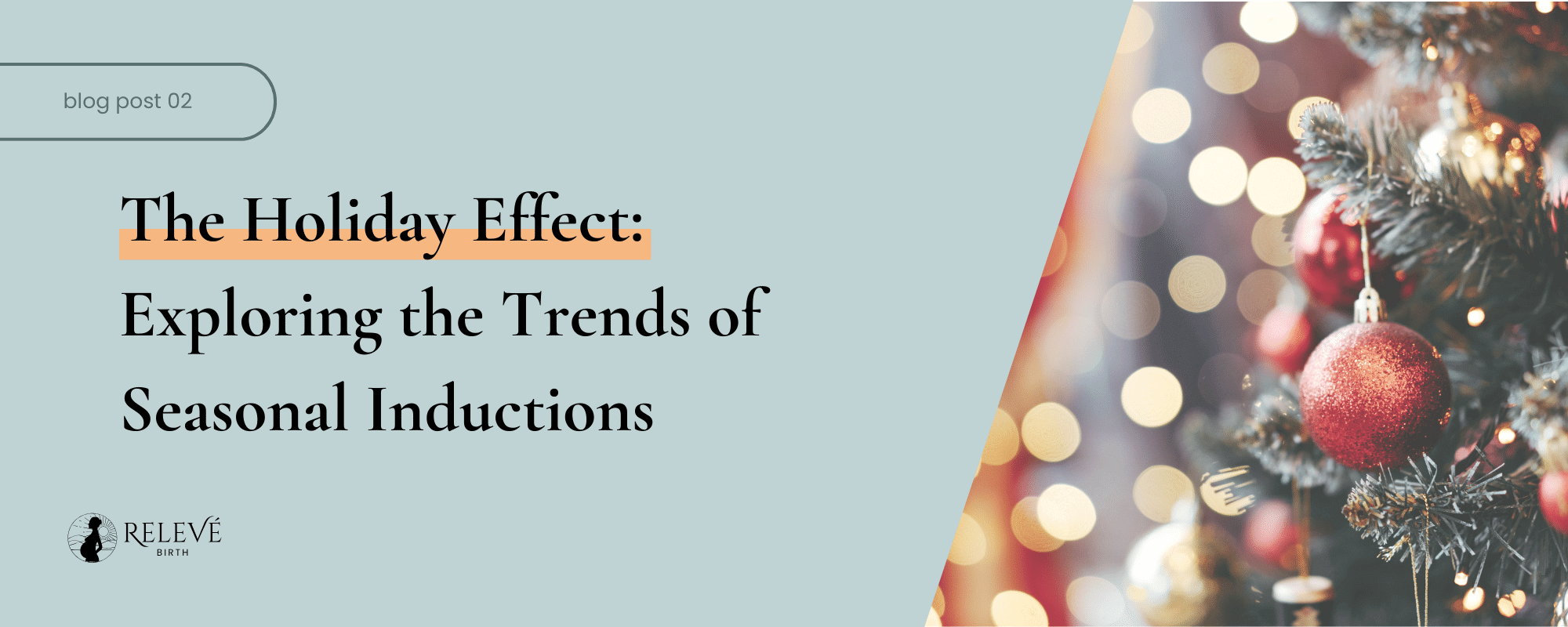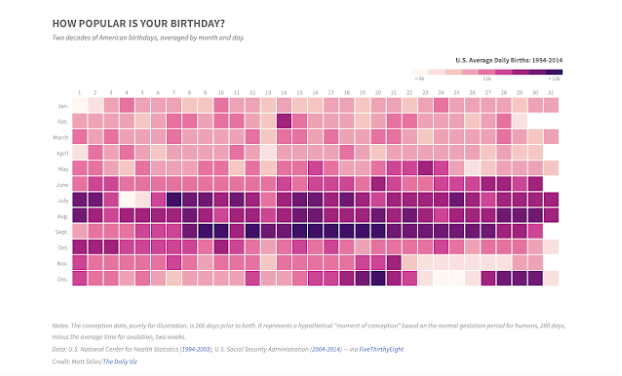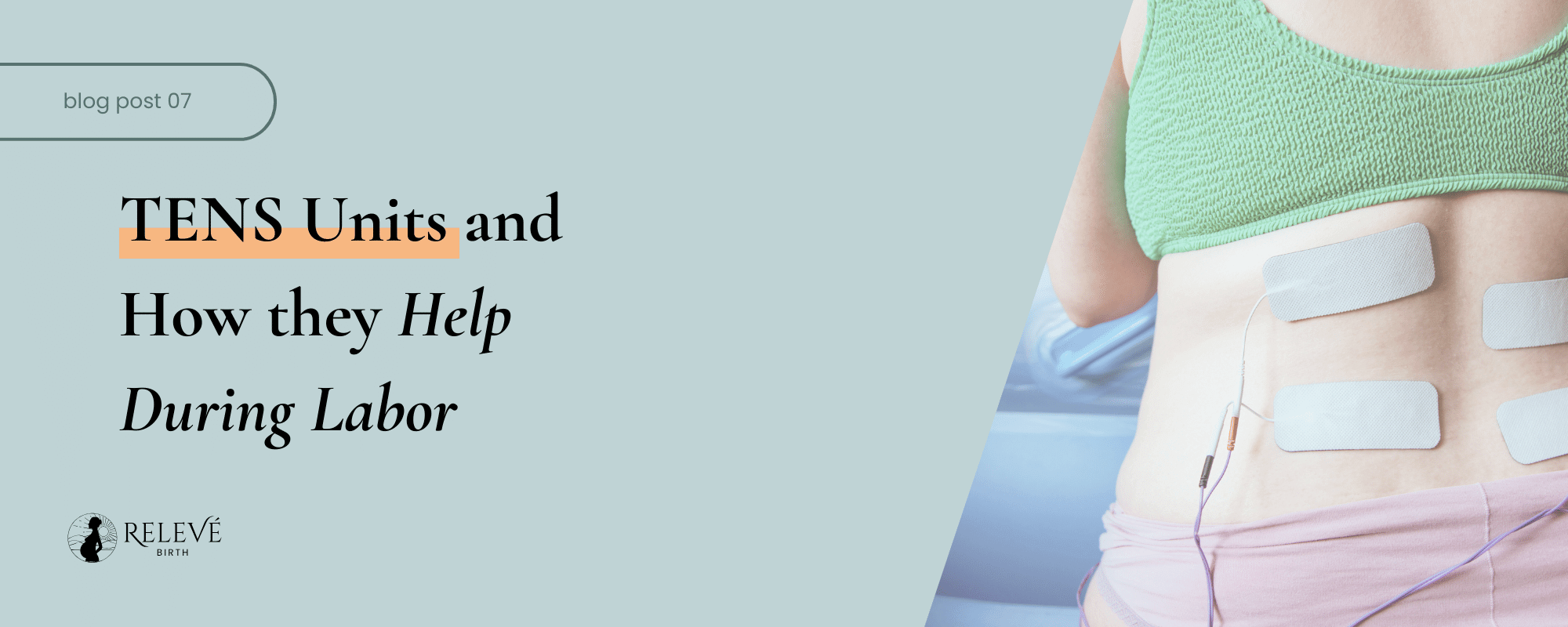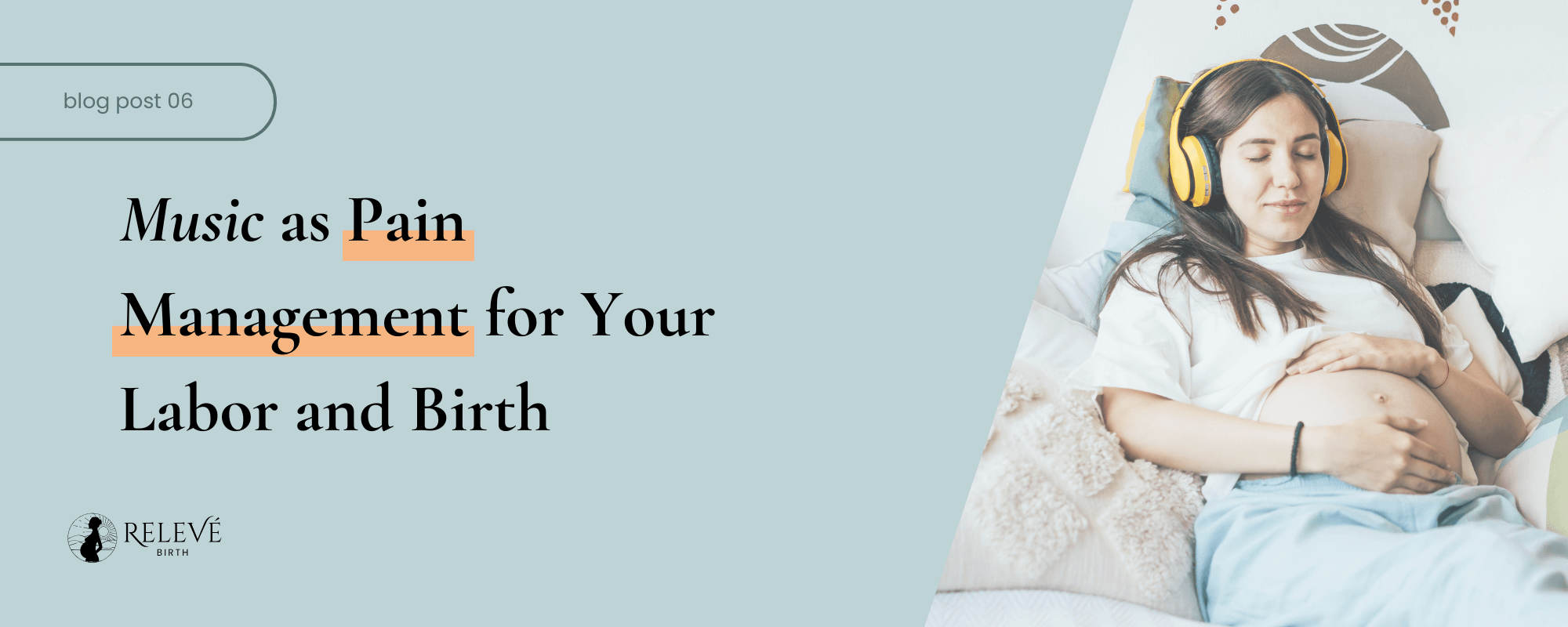The Holiday Effect: Exploring the Trends of Seasonal Inductions
The holiday season is in full effect and everyone is rushing around. The stores are full of shoppers. The traffic is awful and finding parking at the mall is a nightmare. ‘Tis the Season! Haha, but for real. It’s the season of giving, the season of decorated trees and twinkling lights, and the season of planned holiday get-togethers with friends and family. It’s also the season of planned births. Many in the birth work community have witnessed this trend and share anecdotal evidence of an increase in inductions around the holidays.
So, do inductions really increase around the holidays?
This is a chart of the number of births on each day in the US over a span of 20 years (1994-2014). The darker the color the more births that occurred. Conversely, the lighter the color the fewer the births.
One might think that birthdate data would show a random spread throughout the year. Babies are always being born, right? I thought that maybe we would see a trend in late summer, early fall babies because of the cold weather months being prime time to, well… conceive a baby. Well, what do you know? That’s exactly what this chart shows!
What else do we see?
Where are the lightest sections? When I started looking I thought to myself Whoomp there it is! Notice that there are a chunk of light colored days in November? Yep, those line up with Thanksgiving. Could it be a coincidence? Sure. Let’s keep looking. The next set of light colored days are Christmas and New Years. Surprising? Well, not really in my opinion. It looks like the days leading up to and just after those holidays are actually darker than is typical on those surrounding days. It’s almost as if the births are planned for enough time to be discharged before the holiday.
Interesting… Let's keep going!
The 4th of July has the same peak leading up to and just after the holiday. However, after that is the ramp up in birth due to seasonality but there is clearly an avoidance of that particular day. One last thing I noticed was the 13th of each month was lighter than the days around it. Could this be because of superstition? Do people really want to avoid having babies on the 13th? I don’t know. It was just an interesting trend I saw. I’d be curious if you see anything else of interest in that chart.
What is happening?
As an advocate of physiological birth I encourage spontaneous labor, and we all know that you can’t really plan when to spontaneously give birth. Spontaneous ≠ planned. They are by definition opposites. There are also ways to try and “naturally” induce labor, but an induction is an induction no matter the method. When your baby’s lungs and brain are fully developed they will release a hormone that initiates labor.
Each pregnancy is different and all women's cycles are different, so due dates aren’t really anything more than a guess date based on general data. An example I like to use is gardening. When you plant seeds in your garden the plants grow at different rates, right? When the berries on your raspberry bush ripen they don’t all ripen at once do they? No, they don’t. They all ripen differently and on their own schedule. Babies are the same. They will develop and mature on their own schedule and when they are ready, will signal for labor to begin.
Now I don’t want to assume anything here (like that providers are pushing unnecessary inductions or C-sections to avoid working on holidays) but this data makes me wonder. I fully acknowledge that providers aren’t the only ones that may not want to have babies on holidays.
For many people the holidays are a busy time of year, and they might not want to worry about the unknown of birth and choose to schedule it. This is merely a data set that shows there are indeed trends. A couple additional charts to support this can be found here and here.
I also found an interesting study regarding birth timing and post-natal outcomes that had some interesting findings. You can check that out here. In their conclusion, they state that they find births are less common on holidays and the number of births that would take place on those holidays are shifted +/-1 week (we can see the same thing in the above chart). They didn’t find that the method of birth was affected, but they state that they cannot rule out increased induction or cesarean birth without knowing the intended delivery plan of the mothers in the sample. Lastly, this study here suggests that induction of labor is responsible for the patterns found in birthdates.
What can you do?
Well first off there is no one-size fits all approach to birth. You have to consider your specific situation and what is best for you. But if you want to avoid an unnecessary induction you need to educate yourself on your options and what you may be up against. According to a 2020 study, induction rates rose from 9.6% in 1990 to 25.7% in 2018. Surprisingly, over one third of those were elective inductions; meaning that they were chosen not because of a medical reason. When making the decision to induce or not you should consider the benefits, risks, alternatives, and what your intuition tells you.
Often women are pressured into inductions for reasons that truly aren’t evidence based. Have a conversation with your care provider and ask for specific reasons why you need to be induced. If you need time to consider your options or do your own research, ask for things to be written down and take it home to research.
Is your body ready to be induced?
This is something you should ask yourself and your provider. It’s just as important you are in the right headspace for labor and birth as it is your body’s preparedness. Your provider can consider your Bishop Score. This is a method used to determine how likely you are to go into labor soon. This score looks at a few things. The first consideration is the baby’s station, which is the position of the baby’s head in relation to the pelvis. The second consideration is the cervix. Is it dilated? Is it effaced? What position is it in? What is its consistency? Points are assigned and a score is given. The higher the score the more “ready” your body is for labor. This score is also used to determine which induction method may be best for you.
Bottom line!
I’m not saying that all inductions are bad, or all inductions are unnecessary. That’s just not true. The medical advances we’ve made are truly remarkable and lifesaving. I am very grateful to have these options when necessary. Only you know your individual situation, and only you can decide what is best for you. Don’t let a provider pull the old bait-and-switch on you and tell you suddenly that you need an induction. Don’t let their holiday plans disrupt your birth plans. You are in control, and you get to call the shots. Knowledge is your greatest tool. The more prepared you are for what to expect, the better equipped you’ll be to advocate for yourself and your baby.
Disclaimer: This is not medical advice. Please discuss all medical concerns with your care provider. This content is for educational and informational purposes only.
Welcome to the
Relevé Birth Blog!
Here we explore the incredible journey of motherhood. Join me as we delve into empowering insights, easy movement tips and holistic approaches to pregnancy, birth, and postpartum.
Thanks for reading!
Hi, I’m Sierra, a doula with a passion for physiological birth. My mission is to help moms, like you, gain the confidence to wholeheartedly trust their bodies to bring their babies into the world.
Join the movement to a better birth.







